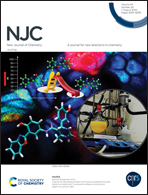Luminescence sensing, DFT, extraction and monitoring of Cr3+ and Al3+via the application of first derivative fluorescence spectroscopy†
Abstract
A novel anthracene containing Schiff base (L) has been developed as a turn-on chromofluorogenic sensor for chromium(III) (Cr3+) and aluminium(III) (Al3+) ions in an aqueous environment. It has been characterized by absorption, emission, FTIR, NMR and mass studies. The receptor shows a significant colour change from blue to green under UV light, in the presence of Al3+ and Cr3+ with limit of detection (LOD) and association constant (Kass) values of 10−11 M and 105 M−1, respectively. In the presence of monovalent and divalent ions (Na+, Hg2+, Pb2+, Cd2+, Ni2+, Co2+, Cu2+, Fe2+, Mn2+ and Zn2+), no significant changes are observed in their spectral patterns. Upon excitation, the ligand exhibits a turn-on emission in the presence of Al3+ and Cr3+, which may be due to chelation-enhanced fluorescence (CHEF), which is further supported by DFT/TDDFT studies. Herein, Al3+, Cr3+, Fe3+ and EDTA have been used to design an advanced level combinational INHIBIT gate. Moreover, this ligand is capable of selectively extracting Al3+ and Cr3+ from an aqueous mixture of other metal ions by the liquid–liquid extraction method. In order to estimate Al3+ and Cr3+ concentrations simultaneously in the mixture without prior separation, first derivative normal fluorescence spectroscopy has been applied.



 Please wait while we load your content...
Please wait while we load your content...